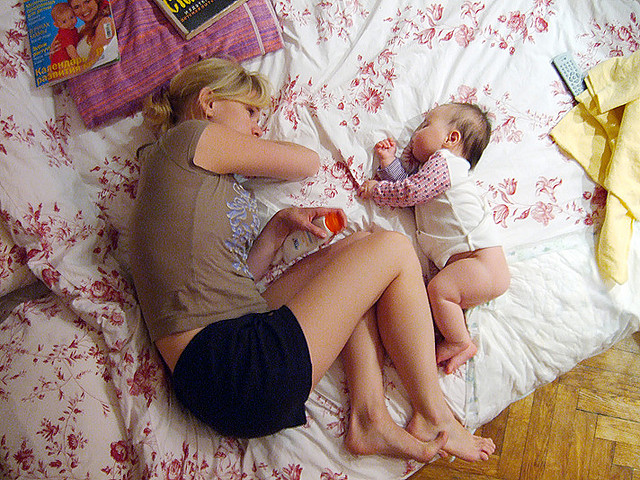There’s a funny paradox for new mothers who are also yogis.
It’s that the one thing you used to do to keep yourself grounded and sane is the one thing you no longer have time or energy to do—right when you need it most.
You’re undergoing the most transformative experience a woman can have, but there is no time to process it. You’re living with the kind of sleep deprivation some countries use as a torture technique while your hormones are careening around like a teenager in a dodgem car. And your body? Let’s just say the benefit of being solely focused on caring for your baby is that you have less time to notice that you’ve either literally been sliced across the middle or torn in places you never thought you’d tear.
As for yoga practice? Hahahaha! Taking time for yoga either feels insanely selfish, or just one more thing to do poorly.
Although yoga had been a steady, grounding presence in my life for 17 years, the thought of “meeting myself on the mat” became unappealing. I didn’t want to have to feel all the yucky feelings that new motherhood bought up. Exhaustion, mixed with adrenaline. Vulnerability. Anxiety that I wasn’t a good enough mother. I didn’t want to practice in the midst of bearing witness to the craziness of “The List”—I must send a million thank-you notes! Get onto years-long childcare waiting lists! Learn about solids! Colic! Baby-proofing! And…did I shower today?!
But simply being willing to witness that inner chaos is the yoga practice. Allowing it transforms it.
So where do you begin? And more importantly, why should you?
What Yoga offers New Mothers.
Culturally, we forget that when a woman gives birth, a mother is also born (as Indian mystic Osho put it). When my son was born last year, I was completely unprepared for how it would change my understanding of the world and my place in it. I was suddenly aware of how fragile a human life can be and no longer felt like my relatively carefree “self.”
Although this was terrifying, I also recognized it as the best opportunity to put yoga to the test in a way I never had before. More than just a series of poses that felt good and a pretty philosophy, yoga became my North Star:
As every illusion I’d ever had about control dissolved, I was able to experience the process as liberating, rather than alarming.
I suddenly understood that “go with the flow” was the only way to live, rather than a trite phrase to toss around when things are going my way.
The yogic precept of “Tapas,” or the fire of discipline that burns away impurities, took on a whole new meaning, as every non-essential aspect of my life was burned away.
And did you know that in new mothers, brain cells connected to experiencing empathy for others are also burned away? Research published this year in Nature Neuroscience showed that parts of our brains associated with understanding the thoughts and feelings of others disappear in inverse proportion to our ability to bond with our babies. Those cells return after about two years, but needless to say, some relationships may take a battering in those early years!
Yoga acts like an anchor in that chaos—a space to safely experience the maelstrom of emotions that new motherhood brings, and a space to gain skills and strength to rise to the new challenges.
New Mother, New Yogi.
Not only are you a new mother, but in many ways you’re also a new yogi.
Because motherhood is such a steep learning curve in itself, it’s not the time to bring an attitude of striving to our practice. Don’t let yoga be another stick to beat yourself with; instead, use your practice to refuel yourself with a liberal dose of self-compassion.
Then comes the next challenge: how do you practice in this new era of “mummy?” Where once your practice was a two-hour sunrise spectacular, it may now be two lots of 10 minutes (if you’re lucky) grabbed whenever you can. Where once you did 20 minutes of sun salutations before perfecting your free-standing inversions, even basic poses like Trikonasana may be beyond you.
Adjusting our practice requires massive doses of humility, patience, and flexibility—qualities you develop pretty quickly as a new parent. And since recovery from birth is different for everyone, I’ve listed tips for practice rather than a specific sequence of postures.
1. Work with what you have.
First of all, get your doctor’s advice before recommencing, particularly if you’ve had separation of the abdominal wall (diastasis recti). A good physio will be able to give you appropriate exercises, so include them in your practice.
Secondly, be mindful that increased relaxin (the pregnancy hormone which relaxes the ligaments in the pelvis and remains in the body months after childbirth) means that, although we may be able to go more deeply into our postures, it’s wise to pull back and focus on containment rather than increasing flexibility in order to maintain joint stability.
2. Ask yourself what you need.
If we consider that the “point” of yoga is union—finding whatever it is we need to feel “whole”—we must begin by asking ourselves what we need from our practice. Accept that while you may not have the time or energy for the kind of full, rounded practice you want, there’s always a way to get the practice you need.
Is today the day you need an energy and mood boost from a 10-minute series of sun salutations? Or are a few gentle joint rotations followed by a guided yoga nidra more your speed? Do you need to focus on shoulder and neck releases while your body gets used to carrying a child? Or chest openers to counter-balance holding your baby while she feeds?
What I needed most in the early days of motherhood was the more intangible sense of “coming back to myself.” In the early days, I spent so much time trying to imagine my baby’s experience of his body (“Is he hungry? Warm enough?”) I all but stopped inhabiting my own. Yoga offered a way back.
3. Develop a “go-to” practice.
For a “complete” asana practice, try and take your spine through the six different orientations: upright, inversion (which could be downward dog), lateral, forward bend, back bend, and twist. You can cover all six with a simple, slow sun salute, plus a lateral posture and a twist.
What feels wonderful in one body will be awful for another, so pick the poses and activities that work for you. I had “go-to” postures I knew worked for my body (hyper-mobile with mild scoliosis) and mixed pilates exercises from my physio into my practice. Certainly for most of us, re-building core strength will be on the agenda.
4. Meditate in motion.
It may seem like something you can put off, but meditation is more beneficial when you have a baby because it takes you out of reacting and into mindful action. Calming the inner chaos will help you to cope with the outer chaos children will bring!
Throw out the idea that you must do a formal, seated meditation for it to be effective. Learn to recognize natural pauses throughout the day (such as showering or heating up milk) and turn them into mini meditation opportunities. I made it a habit to take three slow, conscious breaths the moment I get into the car. Rebecca Ryan’s book Mindfulness for Mothers is full of short practices that mothers can build into their day.
One of my favorite meditations can be done while breastfeeding or walking with the pram. I simply try to notice three things for each of the five senses (three things I can see, three I can hear hear, and so on). It’s a great way to return to the present moment.
5. Make a consistent (small) effort.
Even 10 minutes may seem like a big demand, but by linking yoga practice to another action that must take place means that it will actually happen. For instance, I do mine as soon as my son goes down for his first nap—before the dishes.
Let go of looking for the perfect yoga conditions. Your old yoga space may now hold a changing table, but a commitment to regularity (however that looks) will help your practice gain traction over time. I began with 10 minutes a day, and gradually created a sense of steadiness (Sthira) and ease (Sukha) that I could return to amidst the craziness of sleep deprivation, hormones, and other challenges. Knowing that whatever else is going on, you have that space to dump and recharge is invaluable.
Calming the Hyperarousal of New Motherhood.
If you didn’t know much about your nervous system before having a child, a rudimentary understanding will help steer you toward bringing it back into balance. The autonomic nervous system is made up of the fight-or-flight “stress” state (the sympathetic nervous system, or S.N.S.) and the “rest and digest” state (the parasympathetic nervous system, or P.N.S.).
As much as possible, we need to bring ourselves back into the more restful P.N.S. While we need the S.N.S (it helps us tend to our crying baby throughout the night, no matter how exhausted we are), the demands of caring for a new baby can tip us into the S.N.S. for prolonged periods, and it can be hard to come out of it. Although we’re exhausted, we may still feel “wired,” and it can be hard to rest. You may notice, for example, how frustrating it is when everyone tells you to “sleep while the baby sleeps,” when you actually feel more of an urge to madly rush around and do all the things you don’t have time for while looking after your child.
The bad news is that if we spend too long in this state, our health (and ability to look after our babies) will suffer. The good news is that regularly bringing ourselves back into the P.N.S. state is a skill we can easily learn.
One of the fastest ways we can do this is to practice a restful inversion (when your head is lower than your heart). Enter Viparita Karani, the “cup of tea, a Bex, and a good lie down” for yogis. It’s simple: just lie down with a bolster or cushion under your hips and elevate your legs. Although it’s more commonly known as “legs up the wall,” I prefer resting my legs on a bed or chair as it takes less effort. And if you’re ever going to take the easy option, it’s now. Because the P.N.S. is slower to activate than the S.N.S., stay in this posture for at least five minutes if you can.
Whether you gave birth to your child or they came to you in other ways, motherhood will turn you inside out and back again. Rest assured, you will feel like “you” again, however, the “you” has just changed.
Having a child opened my mind and heart in ways I did not think possible. All too soon, our babies will be grown. Yoga has really helped me slow down and savour this time with my son.
~
~
Author: Alice Williams
Image: Oleg Sidorenko/Flickr
Editor: Callie Rushton
Copy Editor: Danielle Beutell
Social Editor: Leah Sugerman









Read 0 comments and reply